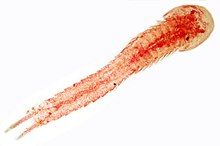Cephalocarida
| Cephalocarida Temporal range:
| |
|---|---|

| |
Hutchinsoniella macracantha
| |
| Scientific classification | |
| Domain: | Eukaryota |
| Kingdom: | Animalia |
| Phylum: | Arthropoda |
| Class: | Cephalocarida Sanders, 1955 |
| Order: | Brachypoda Birshteyn, 1960 |
| Family: | Hutchinsoniellidae Sanders, 1955 |
| Genera | |
| Synonyms | |
| |
The Cephalocarida are a class in the subphylum Crustacea comprising only 12 species. Both the nauplii and the adults are benthic.[1] They were discovered in 1955 by Howard L. Sanders,[2] and are commonly referred to as horseshoe shrimp. They have been grouped together with the Remipedia in the Xenocarida. Although a second family, Lightiellidae, is sometimes used, all cephalocaridans are generally considered to belong in just one family: Hutchinsoniellidae. Fossil records of cephalocaridans has been found in 462 million year old deposits.[3]
Taxonomy
- Class Cephalocarida Sanders 1955[4]
- Order Brachypoda Birshteyn 1960
- Family Hutchinsoniellidae Sanders 1955
- Genus Chiltoniella Knox & Fenwick 1977
- Chiltoniella elongata Knox & Fenwick 1977
- Genus Hampsonellus Hessler & Wakabara 2000
- Hampsonellus brasiliensis Hessler & Wakabara 2000
- Genus Hutchinsoniella Sanders 1955
- Hutchinsoniella macracantha Sanders 1955
- Genus Lightiella Jones 1961
- Lightiella floridana McLaughlin 1976
- Lightiella incisa Gooding 1963
- Lightiella magdalenina Carcupino et al. 2006
- Lightiella monniotae Cals & Delamare Deboutteville 1970
- Lightiella serendipita Jones 1961
- Genus Sandersiella Shiino 1965
- Sandersiella acuminata Shiino 1965
- Sandersiella bathyalis Hessler & Sanders 1973
- Sandersiella calmani Hessler & Sanders 1973
- Sandersiella kikuchii Shimomura & Akiyama 2008
- Genus Chiltoniella Knox & Fenwick 1977
- Family Hutchinsoniellidae Sanders 1955
- Order Brachypoda Birshteyn 1960
Description and anatomy
These are hermaphroditic and pigmentless crustaceans with an elongated and translucent body that measures 2 to 4 mm (0.079 to 0.157 in) in length. A heart is present, and their exopods and pseudepipodites appears to be used for gas exchange.[5][6] They have a large head, the hind edge of which covers the first thoracic segment. The thorax consists of nine limb-bearing segments (thoracic limb VIII absent in Lightiella), followed by 10 limbless abdominal segments and a telson. In the larva, all the trunk segments are ring-shaped, but more dorsoventrally flattened than in the adults. During growth the anterior segments turns into the thorax and the posterior segments which makes up the abdomen remains ring-shaped.[7] No eyes have been observed in either the adult or larval stages, presumably because of their muddy natural habitat. The second pair of antennae is located behind the mouth; in all other crustaceans the antennae are in front of the mouth at the adult stage, and only their larvae have antennae that have the same location as adult cephalocaridans.[8][9]
The mouth is located behind the large upper lip, flanked by
Ecology
Cephalocaridans are found from the
References
- ^ Key for the identification of crustacean nauplii - GfBS
- PMID 16589618.
- ^ Welsh fossils uncover an ancient 'marine dwarf world'
- ^ Boxshall, G. (2010). "Hutchinsoniellidae Sanders, 1955". World Register of Marine Species. Retrieved 2017-12-07.
- ^ Class Cephalocarida Sanders, 19551 in - Brill
- ^ Functional Morphology and Diversity
- ^ Atlas of Crustacean Larvae
- ^ ISBN 978-0-03-056747-6.
- ^ Rediscovery of the horseshoe shrimp Lightiella serendipita Jones, 1961 (Cephalocarida: Hutchinsoniellidae) in San Francisco Bay, California, USA, with a key to the worldwide species of Cephalocarida
- ^ L. A. Zenkevich. "Phylum Arthropoda". The Animal Life [Zhizn' Zhivotnykh]. Vol. 2.
External links
- Cephalocarida- University of California Museum of Paleontology
 Data related to Cephalocarida at Wikispecies
Data related to Cephalocarida at Wikispecies
